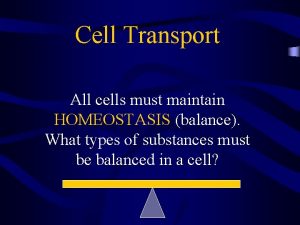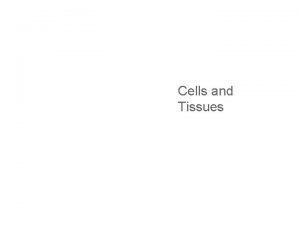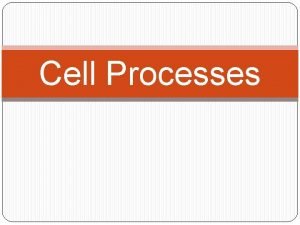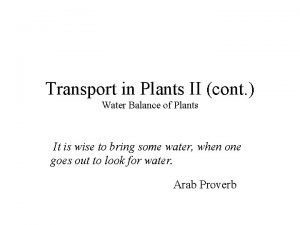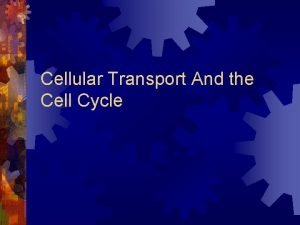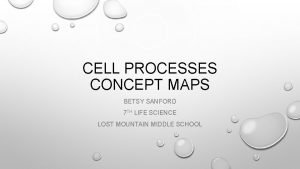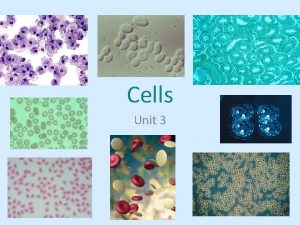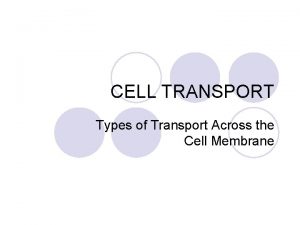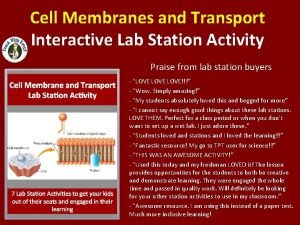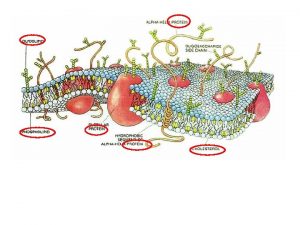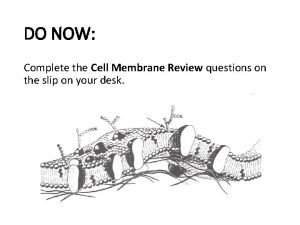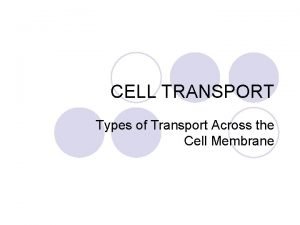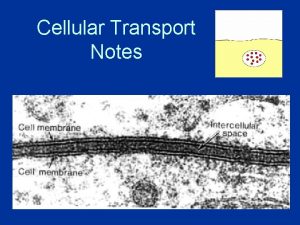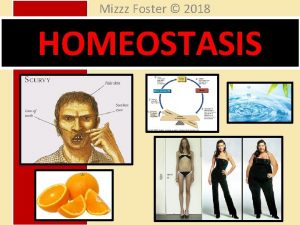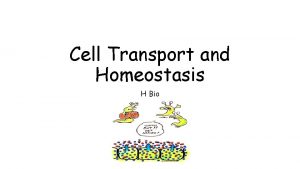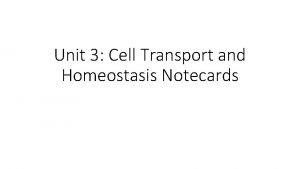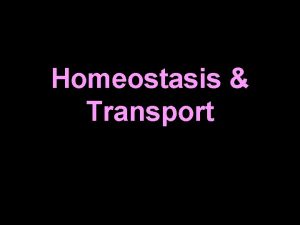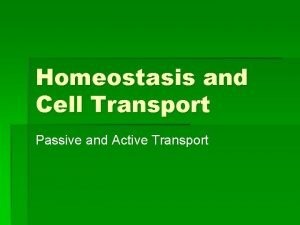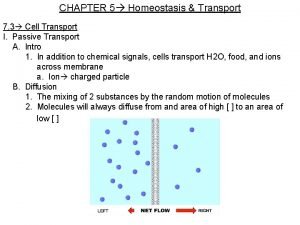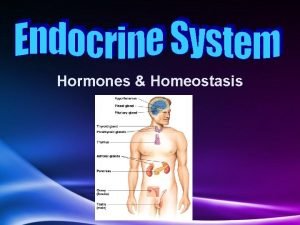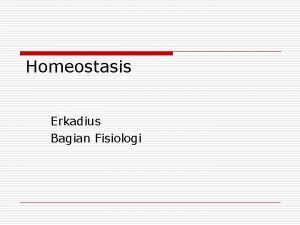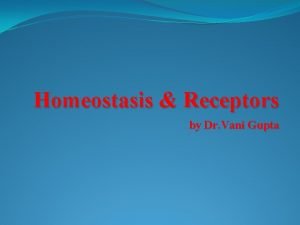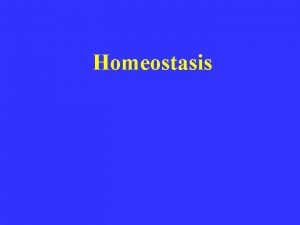Cell Transport Homeostasis What is homeostasis How do









































- Slides: 41

Cell Transport

Homeostasis �What is homeostasis? �How do the terms homeostasis and equilibrium relate to each other? �What are the functions of the cell membrane? �How do you think the cell membrane helps the cell maintain homeostasis?

Cell Membrane (a. k. a. - Phospholipid Bilayer) �Function: Selectively permeable- regulate movement in and out of cell Supports, shapes and protects the cell Communication with other cells �Double Lipid Layer Gives membrane flexible structure Forms a barrier btw. the cell and its surroundings

Components of the Cell Membrane �The cell membrane is made up of three structures: Phospholipids Proteins Carbohydrates

Phospholipids �Double Lipid Layer Gives membrane flexible structure Forms a barrier btw. the cell and its surroundings �Structure Tail= hydrophobic Head= hydrophilic

Movement Across the Plasma Membrane 1. Passive Transport- cellular energy is not used Diffusion Osmosis Facilitated Transport 2. Active Transport- materials move against a concentration difference; requires energy Protein Pumps Vesicles-movement of LARGE molecules (ie. Endocytosis and Exocytosis)

Passive Transport- the process in which substances move into/out of the cell w/o the use of energy … n o d e s a b s i s e c n a t s b u s f o Movement Concentration gradient- the difference in # of molecules per vol. of substance between a high and low concentration region

3 Types of Passive Transport Diffusion Osmosis Facilitated Diffusion

1. Diffusion- net movement of molecules/ions down a concentration gradient (high to low conc. ). Examples: spraying air freshener, making tea or kool-aid

Tea TOOT Air Freshener Cooked Bacon

Diffusion Solute- substance that is dissolved in a solution. Solvent- Dissolving substances in a solution. Solution- type of mixture in which all substances are evenly distributed http: //www. youtube. com/watch? v=s 0 p 1 ztrb. XPY&feature=related

Guess the Solute and the Solvent

What determines diffusion rates �Gradient’s steepness- faster �Molecular size- smaller molecules move down concentration gradient quicker �Temperature- ↑ heat causes molecules to move faster/collide

What affects diffusion? Beaker 1: Hot water (10 drops food coloring) Beaker 2: Luke Warm Water (10 drops food coloring) Beaker 3: Cold water (2 drops food coloring)

What affects diffusion? Beaker 1: Luke warm water (4 drops food coloring) Beaker 2: Luke warm Water (2 drops food coloring) Beaker 3: Luke warm water (1 drop food coloring)

Osmosis- the process by which water molecules diffuse across a cell membrane from a low concentration of solutes to a high concentration of solutes.

Osmosis High conc. of solute/ low conc. of H 2 O Sugar molecules Low conc. of solute/ high conc. of H 2 O Permeable membrane Water molecules pass through but not sugar Water molecules http: //www. youtube. com/watch? v=Xcl. GRjnilsk

Cells & Osmosis �The concentration of the solution that the cell is in, will affect the state of the cell. �Three types of solutions: “Iso”tonic- think “same” “Hyper”tonic- think “above” “Hypo”tonic- think “below”

Isotonic Solution �Isotonic solution- the concentration of solutes outside the cell, is equal to the amount solutes of molecules inside the cell. �Thus, no movement of water occurs into or out of the cell. �The cell remains normal or the same.

Hypertonic Solutions �Hypertonic solution- the concentration of solutes is higher on the outside of the cell than on the inside of the cell. �Thus, resulting in water moving from the inside of the cell to the outside of the cell. �The cell will shrink (crenate) or become smaller.

Hypotonic Solution �Hypotonic solution- the concentration of solutes is lower on the outside of the cell than on the inside of the cell. �Thus, resulting in water moving from the outside of the cell into the inside of the cell. �The cell will increase in size and could explode.

Accountable Independent Reading �While reading you need to: Circle words that are associated with osmosis or diffusion Underline the main point of the article

Facilitated Diffusion �The movement of molecules across the membrane is with the assistance of carrier proteins located within the cell membrane. �Facilitated diffusion is the process used for molecules that can’t diffuse rapidly through the cell membrane. This is due to the molecules being too large to pass through.

Facilitated Diffusion- Carrier Protein A carrier protein binds to the molecule on one side of the membrane. 1. Typically a carrier will only transport a small group of related molecules. 2. The carrier protein changes shape as the molecule passes through. 3. The molecule is then released on the other side of the membrane. Molecule still moves from a high to low concentration

Carrier Protein


Cell Transport 1. Passive Transport- cellular energy is not used Diffusion Osmosis Facilitated Diffusion 2. Active Transport- materials move against a concentration difference; requires energy Vesicles- membrane Endocytosis enclosed sacs that store/ Exocytosis transport substances; used to move LARGE molecules

Active Transport �The movement of substances is against the concentration gradient. Meaning the substances flow from a low to a high concentration. Energy, in the form of ATP is required �The types of active transport are: Endocytosis �Pinocytosis �Phagocytosis Exocytosis

Recap. on Cell Transport

Active transport 34

Carrier proteins involved in active transport are called pumps. The sodium-potassium pump is active in all animal cells, and moves sodium ions to the outside of the cell and potassium ions to the inside. 35

The sodium-potassium pump 36

37

38

39

40

Endocytosis �Process of taking material (fluid, macromolecules, & large particles) into the cell by the infolding of the cell membrane Infolding breaks loose from the cell membrane This forms a vacuole within the cytoplasm �There are two types of endocytosis Pinocytosis Phagocytosis

Pinocytosis �Form of endocytosis �Tiny pockets form along the cell membrane, these fill w/ liquid and pinch off as vacuoles Vacuole- a membranebound cavity within a cell, often containing a watery liquid or secretion.

Phagocytosis �Type of endocytosis �Extensions of cytoplasm surround a particle & package it within a food vacuole

Exocytosis �Process of getting rid of cellular waste or secreting hormones (ie. Hormones from endocrine cells, mucous from secretory cells) �The membrane of the vacuole surrounding the material fuses w/ the cell membrane

 Homeostasis and cell transport
Homeostasis and cell transport Bioflix activity homeostasis hormones and homeostasis
Bioflix activity homeostasis hormones and homeostasis Bioflix activity homeostasis hormones and homeostasis
Bioflix activity homeostasis hormones and homeostasis Secondary active transport
Secondary active transport Active transport
Active transport Now answer the questions
Now answer the questions Passive transport vs active transport venn diagram
Passive transport vs active transport venn diagram Unlike passive transport active transport requires
Unlike passive transport active transport requires Primary active transport vs secondary active transport
Primary active transport vs secondary active transport Bioflix activity membrane transport active transport
Bioflix activity membrane transport active transport Active and passive transport
Active and passive transport Bioflix membrane transport
Bioflix membrane transport Transport cell
Transport cell Cell transport review
Cell transport review Cell transport definition
Cell transport definition Faciliated diffusion definition
Faciliated diffusion definition Transport in plants
Transport in plants 3 types of passive transport
3 types of passive transport Cellular transport and the cell cycle
Cellular transport and the cell cycle Cell transport graphic organizer
Cell transport graphic organizer Cell transport concept map
Cell transport concept map All cells have
All cells have Cell transport
Cell transport Cell transport stations
Cell transport stations Example of active transport in a cell
Example of active transport in a cell Cell transport
Cell transport Cell physiology membrane transport worksheet
Cell physiology membrane transport worksheet Phagocytosis
Phagocytosis Transport cell
Transport cell Cell city project animal cell
Cell city project animal cell Denuding tower
Denuding tower Prokaryotic vs eukaryotic cell
Prokaryotic vs eukaryotic cell Prokaryotic cell and eukaryotic cell similarities
Prokaryotic cell and eukaryotic cell similarities Venn diagram plant and animal cell
Venn diagram plant and animal cell Zn cu
Zn cu Dry cell vs wet cell
Dry cell vs wet cell Plant and animal cell venn diagram
Plant and animal cell venn diagram Cell wall function
Cell wall function Vacuole function
Vacuole function Smooth endoplasmic reticulum function simple
Smooth endoplasmic reticulum function simple Carbohydrate in cell membrane
Carbohydrate in cell membrane 10 cm dish surface area
10 cm dish surface area
